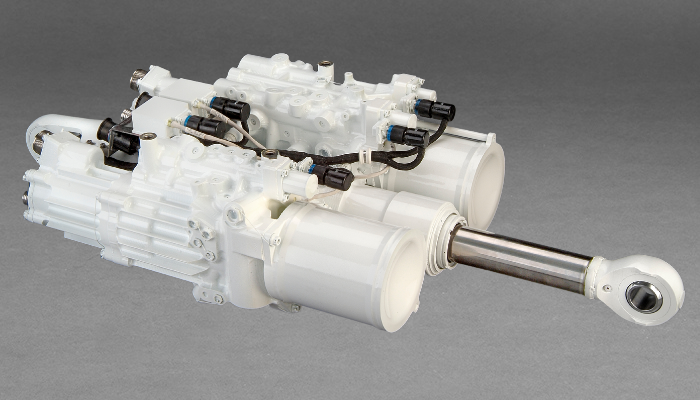Aircraft require hundreds of moving parts to function safely and efficiently during flight. While engines and flight control surfaces receive much of the attention, another vital component that helps move many of these parts are aircraft actuators. These actuators are the unsung heroes that allow planes to take off, land, and maneuver through the air.
What are Aircraft Actuators?
Aircraft actuators are electromechanical or hydraulic devices that help manipulate flight control surfaces and other systems on a plane. Their main function is to convert electrical, hydraulic or pneumatic energy into precise mechanical motion when activated. Actuators help move surfaces like ailerons, elevators, rudders, slats, and flaps which are used to control the plane’s attitude, lift, drag and direction during various phases of flight. Other applications include deploying and retracting landing gears, opening and closing doors, and positioning thrust reversers. Aircraft designers rely on actuators to power flight critical functions with redundancy and reliability.
Types of Aircraft Actuators
There are a few main categories of actuators used across commercial and military aircraft:
Hydraulic Actuators: Hydraulic actuators are the most commonly used type for primary and secondary flight controls due to their power and response time. They work by using hydraulically pressurized fluid to move a piston which connects to control surfaces via push-pull rods or rotary actuators. Military jets and large transports typically rely solely on hydraulic systems for critical flight functions.
Electronic Actuators: With advances in electric motors and controls, more aircraft are utilizing electric “fly-by-wire” systems with electronic Actuators. These provide precise movements and remove hydraulic fluids that can leak or catch fire. However, they require backup hydraulic or mechanical systems for redundancy. Regional jets and new aircraft often feature hybrid electro-hydraulic designs.
Pneumatic Actuators: Some small, non-critical functions like landing gear or door operations use pneumatic actuators powered by pressurized bleed air. They are simpler and lighter than hydraulic options but provide less power for primary flight controls.
Mechanical Actuators: A few mechanical linkages without powered actuators still exist, especially for backup systems. Though low maintenance, they have weaker force and response times compared to active actuators.
How Aircraft Actuators Work
All types of actuators function on the basic principle of exchanging potential or stored energy into precise, controlled motion. Hydraulic actuators use high-pressure oil directed through tubing by electric pumps. It moves pistons attached to control surfaces via push-pull linkages. Electronic actuators instead precisely regulate electric motors which directly or indirectly move the controls. Pneumatic ones use compressed air to push or pull attached components.
In operation:
– Pilot input commands are sent to the flight control computer.
– The computer activates the appropriate actuators selectively based on control laws and surface positions.
– Pressurized hydraulic fluid or electric current moves the actuator’s linear or rotary motors.
– Attached linkage rods or cables transfer the power from the actuator to flex or rotate the aileron, elevator, etc.
– Position and load sensors provide feedback to the computer, ensuring accurate control surface responses.
– Auto pilots and fly-by-wire systems now directly control actuators without manual input, enhancing safety.
Importance of Actuators in Aviation
Aircraft actuators are literally the muscle behind flight. With tens to hundreds required per plane, they move almost every external surface and internal mechanism critical to safe operations. Their constant precision and reliability often go unnoticed until a failure occurs. Some key reasons actuators are so important:
Redundancy – Modern aircraft have multiple actuators per control surface with different power sources. This prevents single points of failure from causing loss of control.
Response – Actuators provide the power and speed needed for pilots or auto flight systems to instantaneously correct for upsets and fly precisely in all regimes.
Durability – Despite extreme temperatures, pressures, vibrations and millions of cycles, actuator designs ensure long operational lifespans in harsh environments.
Control Authority – Actuators multiply human strength to generate the high forces required to flex large surfaces at any airspeeds or maneuvres. Without them, controls would be ineffective.
Safety Systems – Actuators enable features like thrust reversers, spoilers, ground spoilers and airbrakes that aid in landings and emergencies through computer automation.
Overall, the reliable actuated motion behind every nautical mile of commercial and military flight proves these components are indispensable technicians in aviation’s behind-the-scenes operations. While pilots control where aircraft go, actuators control how they get there through the collective works of many unsung actuated heroes. Continued technological innovations will keep improving aircraft actuator designs for even greater safety, efficiency and performance in aviation’s future.
*Note:
1. Source: Coherent Market Insights, Public sources, Desk research
2. We have leveraged AI tools to mine information and compile it



